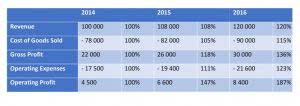Content

Subsequently, the net debit or credit balance from the income summary is posted to retained earnings. The dividend closing entry records any dividends to be distributed to the shareholders. The income summary account (or income summary report) is a special account created to facilitate the closing process and to leave an audit trail. Because the income summary account is an optional step in the closing process, some firms choose to skip it and close all accounts out to retained earnings. Closing entries are journal entries made at the end of the accounting cycle to move temporary (nominal) account balances into permanent accounts.

In a general financial accounting system, temporary or nominal accounts include revenue, expense, dividend and income summary accounts. Closing journal entries are exceptional because, https://www.bookstime.com/articles/closing-entries unlike most journal entries, there are no transactions taking place. This means that whatever the normal balance for any given account is, it will be zeroed out by an opposing entry.
Definition of Closing Entry
Because this is a positive number, you will debit your income summary account and credit your retained earnings account. Finally, you are ready to close the income summary account and transfer the funds to the retained earnings account. https://www.bookstime.com/ You must debit your revenue accounts to decrease it, which means you must also credit your income summary account. This will zero out the balance in each of the expense accounts and transfer it to the income summary account.
- Both methods are correct with each having its advantages and disadvantages.
- For instance, the year 2020 revenue and expense accounts would show the balances pertaining to just that year and not for 2019 or 2018.
- The third entry requires Income Summary to close to the Retained Earnings account.
- The account has a zero balance throughout the entire accounting period until the closing entries are prepared.
- If your revenues are less than your expenses, you must credit your income summary account and debit your retained earnings account.
This type of entry is made at the end of an accounting period and its purpose is to zero out all temporary accounts so that they are ready to be used in the next accounting period. Without closing entries, a company’s financial statements would be inaccurate and incomplete. You begin the closing process by transferring revenue and expense account balances to the income summary account, a temporary account used specifically to transfer revenue and expense account balances. The second entry requires expense accounts close to the Income Summary account.
What are the 4 closing entries?
The balances of these accounts are eventually used to construct the income statement at the end of the fiscal year. Once all of the required entries have been made, you can run your post-closing trial balance, as well as other reports such as an income statement or statement of retained earnings. What is the current book value of your electronics, car, and furniture? Are the value of your assets and liabilities now zero because of the start of a new year? Your car, electronics, and furniture did not suddenly lose all their value, and unfortunately, you still have outstanding debt. Therefore, these accounts still have a balance in the new year, because they are not closed, and the balances are carried forward from December 31 to January 1 to start the new annual accounting period.
What are closing entries with example?
For example, a closing entry is to transfer all revenue and expense account totals at the end of an accounting period to an income summary account, which effectively results in the net income or loss for the period being the account balance in the income summary account; then, you shift the balance in the income …
For our purposes, assume that we are closing the books at the end of each month unless otherwise noted. Closing entries help in the reconciliation of accounts which facilitates in controlling the overall financials of a firm. Manual processes struggle to handle the increasing volume of financial transactions and complexities. Consider the following example for a better understanding of closing entries. Answer the following questions on closing entries and rate your confidence to check your answer. We have completed the first two columns and now we have the final column which represents the closing (or archive) process.
AI-Based Deduction Management Software
In simple words, closing entries are made to close the books for an accounting period. The income summary account is a temporary account solely for posting entries during the closing process. It is a holding account for revenues and expenses before they are transferred to the retained earnings account. Transferring funds from temporary to permanent accounts also updates your small business retained earnings account.

A company will see its revenue and expense accounts set back to zero, but its assets and liabilities will maintain a balance. In summary, the accountant resets the temporary accounts to zero by transferring the balances to permanent accounts. The balance in dividends, revenues and expenses would all be zero leaving only the permanent accounts for a post closing trial balance. The trial balance shows the ending balances of all asset, liability and equity accounts remaining. The main change from an adjusted trial balance is revenues, expenses, and dividends are all zero and their balances have been rolled into retained earnings. We do not need to show accounts with zero balances on the trial balances.
15 Closing Entries
You might be asking yourself, “is the Income Summary account even necessary? ” Could we just close out revenues and expenses directly into retained earnings and not have this extra temporary account? We could do this, but by having the Income Summary account, you get a balance for net income a second time. This gives you the balance to compare to the income statement, and allows you to double check that all income statement accounts are closed and have correct amounts. If you put the revenues and expenses directly into retained earnings, you will not see that check figure. No matter which way you choose to close, the same final balance is in retained earnings.
- To get a zero balance in a revenue account, the entry will show a debit to revenues and a credit to Income Summary.
- A temporary account records balances for a single accounting period, whereas a permanent account stores balances over multiple periods.
- The balances of the income summary account will eventually also be transferred to the retained earnings account on the balance sheet.
- No matter which way you choose to close, the same final balance is in retained earnings.
- You can report retained earnings either on your balance sheet or income statement.
As part of the closing entry process, the net income (NI) is moved into retained earnings on the balance sheet. The assumption is that all income from the company in one year is held onto for future use. One such expense that is determined at the end of the year is dividends. The last closing entry reduces the amount retained by the amount paid out to investors. Permanent accounts, on the other hand, track activities that extend beyond the current accounting period.
You must cCreate an account to continue watching
You can report retained earnings either on your balance sheet or income statement. Without transferring funds, your financial statements will be inaccurate. If income summary account has a debit balance, it means the business has suffered a loss during the period which decreased decrease its retained earnings. In such situation, the income summary account is closed by debiting retained earnings account and crediting income summary account. Notice that revenues, expenses, dividends, and income summary all have zero balances.
- The eighth step in the accounting cycle is preparing closing entries, which includes journalizing and posting the entries to the ledger.
- When you manage your accounting books by hand, you are responsible for a lot of nitty-gritty details.
- Examples of accounts not affected by closing entries include asset, liability, and equity accounts.
- It stores all of the closing information for revenues and expenses, resulting in a “summary” of income or loss for the period.
- Once you have completed and posted all closing entries, the final step is to print a post-closing trial balance, and review it to ensure that all entries were made correctly.
- Closing entries are manual journal entries at the end of an accounting cycle to close out all the temporary accounts and shift their balances to permanent accounts.
One of your responsibilities is creating closing entries at the end of each accounting period. Whether you’re processing closing entries manually, or letting your accounting software do the work, closing entries are perhaps the most important part of the accounting cycle. While these accounts remain on the books, their balance is reset to zero each month, which is done using closing entries. The accountant can choose either method as eventually all the accounts will be transferred to the retained earnings account on the balance sheet.
Closing entries are an important part of accounting as it helps in preparing accurate financial statements. These entries help in understanding a company’s profitability, making decisions, and in preparing budgets. So if you are an accountant or someone interested in learning about accounting, it is important to understand the concept of closing entries.

